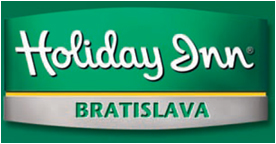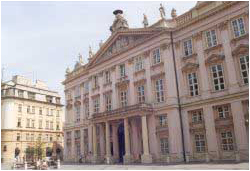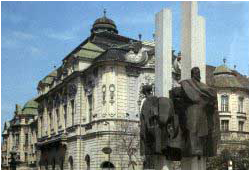| Holiday Inn - Bratislava |
 The
121st CIA Winter Congress will be held at the Holiday Inn - Bratislava, SLOVAKIA from January 30 - February 1, 2009. The
121st CIA Winter Congress will be held at the Holiday Inn - Bratislava, SLOVAKIA from January 30 - February 1, 2009.
The Holiday Inn is situated in an important business district, near historical center of the Bratislava and 40 km from Vienna's airport Schwechat.
The hotel creates the ideal atmosphere for a relaxing stay, no matter whether you are travelling on business or on holiday in Bratislava.
Wireless internet connection is available to our clients in the public area, on the 2nd floor and in meeting rooms.
For your security all the hotel premises are monitored by camera system.
The elegant restaurants Brasserie, Winter Garden and Pizzeria, with the capacity up to 180 covers, offers a choice of slovak, international and italian food.
Our culinary team will be pleased to serve you with something special.
The great place to relax is our leisure center with the swimming pool, sauna, solarium, massage, gym, tennis court, all contribute to make your stay with us even more attractive.
3 conference halls with a capacity up to 400 persons as well as 5 smaller meeting rooms with the most modern equipment to meet requirements for all kind of events.
There is ample free parking at the hotel and an in-house parking garage.
Hotel Address:
Holiday Inn Bratislava
Bajkalská 25/A
825 03 Bratislava, Slovakia
RECEPTION
Tel: +421 (0) 2 482 45 111
Fax: +421 (0) 2 482 45 112
E-mail: holidayinn@holidayinn.sk
|
|
|
|
|
| Welcome
to Bratislava, Slovakia |
 Not only is Bratislava the largest city in Slovakia, it also serves as the state capital. Furthermore, Bratislava is the seat of the National Council of the Slovak Republic, the Government of the Slovak Republic, national ministries and the other central bodies of the state administration of the Slovak Republic. It is situated in the centre of Europe in the southwestern part of Slovakia. Not only is Bratislava the largest city in Slovakia, it also serves as the state capital. Furthermore, Bratislava is the seat of the National Council of the Slovak Republic, the Government of the Slovak Republic, national ministries and the other central bodies of the state administration of the Slovak Republic. It is situated in the centre of Europe in the southwestern part of Slovakia.
It borders with Hungary in the south and with Austria in the west. The town spreads like a fan on both banks of the Danube River, and at the foot of the Low Carpatians. Due to its position on the border between the mild and warm climatic zones, it ranks among the warmest spots in Slovakia with an average temperature of 9.9 C. It has 1 976.4 hours of sunshine a year and annual total rainfall is 527.4 mm. Bratislava is the most populous city in the Slovak Republic and its population is some 450 000.
A major industrial center, Bratislava is known for building VW cars and historically the manufacture of furniture, chemicals, tobacco products, musical instruments, woolen goods, and leather products. Historical points of interest include an 11th-century Gothic cathedral that was restored in the second half of the 19th century; a former royal palace of Hungary, on a hill overlooking the city; a 13th-century Franciscan church; the town hall, a 13th-century edifice; the Comenius University of Bratislava (1919); the Slovak Technical University in Bratislava (1938); and the Slovak Academy of Sciences (1953).
 Founded before the 10th century, the city was known originally as Pressburg. Strong fortifications erected during the 12th century gave it strategic importance; from 1541 to 1784 it was the capital of Hungary. In 1805, during the Napoleonic War, the Peace of Bratislava was signed in the Primate's Palace (pictured below) following the defeat of the armies of Francis I, the Austrian emperor and Alexander I, the Russian tsar by Napoleon's army at Austerlitz (Slavkov). When Czechoslovakia was created in 1919 after World War I, the city was renamed Bratislava and made capital of the province of Slovakia. Founded before the 10th century, the city was known originally as Pressburg. Strong fortifications erected during the 12th century gave it strategic importance; from 1541 to 1784 it was the capital of Hungary. In 1805, during the Napoleonic War, the Peace of Bratislava was signed in the Primate's Palace (pictured below) following the defeat of the armies of Francis I, the Austrian emperor and Alexander I, the Russian tsar by Napoleon's army at Austerlitz (Slavkov). When Czechoslovakia was created in 1919 after World War I, the city was renamed Bratislava and made capital of the province of Slovakia.
Founded before the 10th century, the city was known originally as Pressburg. Strong fortifications erected during the 12th century gave it strategic importance; from 1541 to 1784 it was the capital of Hungary. In 1805, during the Napoleonic War, the Peace of Bratislava was signed in the Primate's Palace (pictured below) following the defeat of the armies of Francis I, the Austrian emperor and Alexander I, the Russian tsar by Napoleon's army at Austerlitz (Slavkov). When Czechoslovakia was created in 1919 after World War I, the city was renamed Bratislava and made capital of the province of Slovakia.
|
|
|
| Tentitive
Schedule of Events |
Thursday
- January 29, 2009
- all
day - arrivals to Slovakia
- all day
- free time for visiting Bratislava
Friday
- January 30, 2008
-
arriving by 2:15 PM for Bus from Vienna Airport/ Bratislava Airport to Hotel Holiday Inn, Bratislava
-
3:00 PM - 7:00 PM Meetings of the CIA Executive Committee - Winter Garden (Holiday Inn)
-
8:00 PM - Welcome Reception - Winter Garden (Holiday Inn)
Saturday
- January 31, 2008
Sunday
- Feburary 1, 2009
Monday
- February 2, 2009
|
| Sightseeing
in Bratislava |
As you arrive at the main train station, you'll see vineyards on the slopes of the Little Carpathian Mountains, where they meet the Danube River. The Austrian border is almost within sight of the city and Hungary is just 16 km away. Many beautiful monuments survive in the old town to tell of its past under Austro-Hungarian rule, and Bratislava's numerous museums are surprisingly rich. Franz Lizst visited Bratislava 15 times, and the opera productions of the Slovak National Theatre rival anything in Europe. Bratislava isn't as swamped by Western tourism as are Budapest and Prague (although this is changing with the advent of low cost flights from around Europe).
The old city and the castle are the best parts of Bratislava. The old city is packed with museums (such as the Municipal Museum which comes complete with torture chambers and the Museum of Wine Production) and palaces (Primate's Palace? and the Mirbach Palace). The castle, built above the Danube, was a frontier post of the Roman Empire from the 1st to the 5th century. Since the 9th century it has been rebuilt several times, most recently between 1953 and 1962. Climb up for the great views and to check out the very interesting Slovak National Museum expositions within. The Natural Sciences Museum of the Slovak National Museum and the Slovak National Gallery on the river are also worth a visit.
Hviezdoslavovo nmestie (square) is a convenient orientation point, with the old town to the north, the Danube to the south, and Bratislava Castle to the west. Bratislava's main train station, Hlavn stanica, is several km north of town. Most of the cheaper hostels and mid-priced hotels are north-east of the centre. The Old Town offers numerous good places to eat and a rich nightlife. |
|
|
|
|
| Contact
Information |
CIA Winter Congress Organizer:
Tibor Racz e-mail: racztibor53@gmail.com
alternate e-mail: racz.tibor@stonline.sk
|
|
|
|